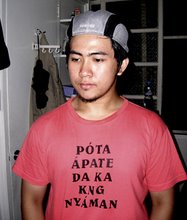
We call them magdarámé (those having their backs blade-wounded and whipping their backs with bamboo pads while walking half-naked and barefoot on the street) and magsalibatbat (those rubbing their skin against the hot concrete by crawling).
The act of having one's back wounded by either a steel or glass blade and letting it bleed is, according to folks, pamagparaya, from the rootword daya, or blood.
However, it is not until this year that I have decided to know more about them by attending the famous Cutud crucifixion rites last Good Friday, where a number of flagellants -- mostly men -- are literally nailed to the cross generally because it's their religious pledge.
 If you've seen the Mark Meily movie La Visa Loca starring Robin Padilla and Rufa Mae Quinto, you'd know what I'm talking about.
If you've seen the Mark Meily movie La Visa Loca starring Robin Padilla and Rufa Mae Quinto, you'd know what I'm talking about.(The character of Robin in that movie, by the way, was supposed to be a Kapampangan who lives in Sexmoan, Pampanga; however, he uttered not a single Kapampangan word.)
It was Good Friday, so naturally, there were a few people out on the streets. I equipped myself with my camcorder to document the whole thing so that I may feature it in my YouTube magazine show. Right in front of the gate of our subdivision, I did not expect to see so many magsalibatbat at eight in the morning.

While riding an Angeles-San Fernando jeepney, I noticed that the others inside the jeepney were dressed like tourists. One is even an American. It seemed as though we all had the same destination: Cutud, for also the same motive.
When I and my friend reached the hill where the crucifixion was to take place, I was overwhelmed with the popularity of the event: from the specially-treated tourists from France, Japan, UK, USA, India, Germany, S. Korea, etc. to the footage-craving media men and photographers from different local, national, and even international papers and networks. Not to mention the usual natives watching their fathers, brothers, or friends participate in the event.

The local government probably expected the number of viewers so they took all measures to make the event very organized.
On the right of the hill is a VIP area dominated by foreigners, tourists, and photojournalists. On the left is a moshpit for locals and non-special viewers. TV camera people were also situated there, although put on an elevated stage for them to get a clear view.
Although it was a practice not appreciated by the Church, I saw nuns attend the event, too.
 Wanting to get closer shots without the interference of umbrellas in my view, I went to the information area and asked whether I could be admitted in the VIP area.
Wanting to get closer shots without the interference of umbrellas in my view, I went to the information area and asked whether I could be admitted in the VIP area.Fortunately, I was recognized by a certain lady through this blog, as recommended by book writer Dr. Tec Olosa. I begged, "Sigi na, media na ku man. Para kng Internet."
And I and my friend were given our special Maléldo IDs! We were officially media people (which I believe I technically am, for new media).
The crucifixion was to happen at lunchtime, so that meant about 45 minutes of waiting under the sun. One would be foolish to abandon his spot because other tourists would quickly take over, pushing your spot backwards, where your view would be filled with raised cameras, hats, and umbrellas.

While waiting, the announcer was telling the people repeatedly a brief history of the practice.

Unbeknownst to many, the Cutud crucifixion rite is actually theatrical in nature. It's a street play, staging the piece Via Crucis (Way of the Cross) written and began by a certain Tata Legring back in 1955. He's deceased today, so it was his grandson Allan Navarro who continued staging the play.

It's actually a reenactment in Kapampangan language of the crucifixion itself -- Jews, Roman soldiers (borne in real horses and holding their spears), the Virgin Mary, and other essential characters were all present in low-budget costumes.

The play is nothing grand, like there was a story to it or there was lighting and original sound effects (Gregorian music was what was being played). In fact, the people were eagerly waiting for the crucifixion itself, as in the idea of really nailing one's palms and feet, not the reenactment.

Several men were crucified. They were removed from the cross after about ten to fifteen minutes of public exposure.
Surprisingly, news say a woman had herself crucified during the latter part. Sadly I wasn't able to witness that. In a patriarchal tradition such as this, women often take the role of the Virgin Mary and other women below the cross.
Jesus Christ, being male, is understandably to be imitated by men alone traditionally. To my confusion and laughter, some supposed-to-be women roles were acted by straight men, too.
However, the Kristos, more than imitation, engaged in such activity not to reenact Christ's life, but to have a wish granted by God.
For instance, one guy I interviewed (I'm sorry I didn't get his name; it was an experimental crash interview using the Kapampangan language; I went straight to him after he was interview by National Geographic) did it because he wanted certain family members to be cured of certain ailments.

An interesting question raised by the Dulaang UP play Shadows of the Reef (Mga Anak Ng Dagat) which features a similar crucifixion rite in a fishing village: what if it was a Catholic woman who wanted something granted? In the play, the folks didn't want the woman to be Kristo because she simply was not a man.
 Anyway, the good thing is, Kapampangans don't care whether it was a man or woman who get themselves crucified.
Anyway, the good thing is, Kapampangans don't care whether it was a man or woman who get themselves crucified.The bad thing is: some Kapampangan children tend to imitate the relatively violent penitential acts.
A few children I saw days ago were hitting one another with things they imagine as the whips used by magdarámé while shouting, "Magdarámé! Magdarámé!" One kid was even lying down on the concrete with his arms stretched wide, pretending to be a Kristo.
But it's probably normal. One can see more violence -- guns, bombs, knives, and fireballs -- in both free and cable TV.









2 comments:
I made sure the history of the Via Crucis was read to add some history into what would otherwise be a circus. Next year, I also told them to play the Pabasa instead of Led Zeppelin's "Stairway to Heaven" which was even mentioned in CNN.com. Hehe!
And I'll also raise the point that you can't go up the hill during the play unless you're in costume. No city councilors trying to get attention unless they don a costume, or tanods in baseball caps and political t-shirts.
Post a Comment